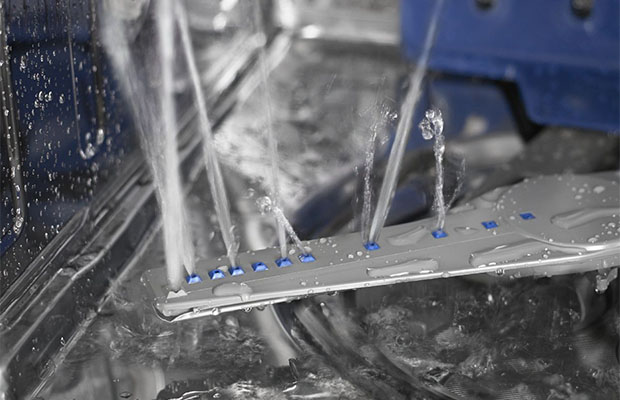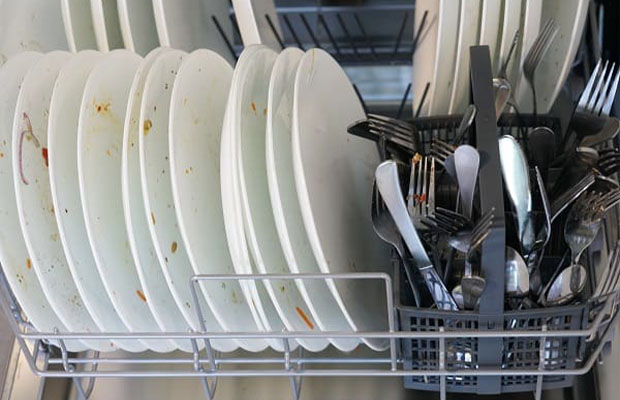If your dishwasher not spraying water, the problem may be mechanical or electrical. Don’t worry, we can assist you in finding a solution.
The circulation pump, spray arms, chopper blades, or even the water inlet valve may in many cases be the cause of your dishwasher’s water spraying issues.
Your dishes won’t be cleaned at all if the water doesn’t spray. Both annoyance and hygienic are present. So without further ado, let’s see why is dishwasher not spraying water and how to fix it.
Table of Contents
Why a Dishwasher Doesn’t Spray?
If you did check the inside of the tub and found it is filled with water, now it is time to move on to the actual issues causing a dishwasher not to spray anything. Why isn’t it functioning if it has a supply of water?
Blocked Spray Arm
Tetris is frequently used to describe the process of loading a dishwasher. There are times when it is not a good idea to cram in as many dirty dishes as you can. Your dishes might not be cleaned thoroughly if it’s there. An overloaded dishwasher may also be the problem if you think the spray arm isn’t rotating. It won’t function if something prevents it from rotating. The handle of a pot or frying pan can frequently obstruct proper motion. You’ll almost certainly be able to hear it, though, if that’s the case. The spray arm will try to turn, but it will bump up against the obstacle as it does so.
An unfortunate problem that can result from repeatedly overloading a dishwasher is that obstruction can result in a damaged spray arm, which may have actually been the original cause of this problem.
Clogged Or Broken Spray Arm

The spray arm itself should always be your first port of call when your dishwasher isn’t spraying water. Actually, this component of your dishwasher isn’t that complicated. Your dishes are sprayed with water that is forced out of a pump, but there are many potential problems with that.
You should visually inspect the spray arm for lime buildup if your home uses hard water. This is especially dangerous for the spray arm’s tiny holes, but a blockage could also have happened further inside. Unfortunately, the best course of action is to insert a small piece of wire into the small holes in your spray arm to unclog them. To soak the arm, you can use products like Lime Away, but be careful the product isn’t too caustic or the plastic will get damaged. We also advise purchasing a water softener, at the very least for your appliances, if the clog was caused by hard water, as you might anticipate. A machine’s lifespan will be extended by years.
When a dishwasher is overloaded, it is possible that the spray arm will become too clogged or will have a part broken on it. The spray arm needs to be changed if this is the situation.
You must remove the bottom dish rack from your dishwasher in order to access the spray arm. Locking tabs hold the spray arm in place. The spray arm will instantly pull up once those are released, allowing for the insertion of the new one.
Circulation Pump
The pump is what forces the soapy water from the tub through the spray arm. Occasionally, food particles may become stuck in this pump and have an impact on its operation. The pump, however, is also capable of going completely faulty and ceasing to function properly.
Right underneath your spray arm, there is a circulation pump. The spray arm, the spray arm assembly, and the bottom dish rack must all be taken apart. The screws holding the circulation pump in place can then be accessed after removing the filter.
There shouldn’t be much resistance to the circulation pump’s motion. To visually check for any obstructions, you should remove it first. If there aren’t any food crumbs or hairs wrapped around the shaft, the component is probably defective and needs to be replaced. This repair should come last because it requires more work than the other options mentioned above. It is uncommon for the pump to actually fail because the filter typically prevents blockages from occurring here. When all other possibilities have been tried, though, it’s time to check the circulation pump.
Dishwasher is Overloaded
One problem that you may encounter with your dishwasher is an excessive amount of dishes. There are two risks associated with this. The first problem is that having too many dishes can give the impression that the dishwasher is unable to clean them because the dishes’ height prevents the water from soaking other objects.
When there are too many dishes, especially those that are taller in shape, the water can’t spray onto other dishes. The second problem is that the weight of the dishes will make your dishwasher either not work at all or work poorly. Again, fixing this is not difficult.
Despite being full, your washer is not cleaning the dishes. What should you do? Try to take out a quarter of the dishes in your dishwasher and run it again. If it’s only a problem with the dishwasher being crowded, you should see an improvement after running it again and pressing “start.”
Float Switch Problem
Dishwasher float switches are a safety feature that stop flooding. The switch will turn off and stop any further water from entering if there is too much water already there. But what happens if your float switch malfunctions? When there is no water coming in, the switch may believe the dishwasher is full of water and shut it off.
The float and the microchip are the two main components of a dishwasher that are connected to the water level. A multitester set to 1 ohm can be used to determine whether a chip is defective. You can tell if a float is defective by some signs, like wear and tear.
Consider a scenario in which your float switch malfunctions. Fortunately, replacing most float switches is simple and affordable. The only issue is that most people prefer to hire a repairman because they don’t want to do it themselves. Although it is entirely up to you, if you are comfortable and skilled with electrical equipment, we advise you to do it yourself.
Water Supply Issue
Your dishwasher is not being contaminated by water. Sometimes this is because the water isn’t turned on, sometimes it just needs a few minutes to heat up. If this is the case, try to start the dishwasher and listen for water coming out of the bottom of the appliance. If there is no sound and you are certain that the water is on, we should concentrate on your water supply rather than the machine itself.
If your model runs more quietly, open it to check for water in the bottom tub. If there is no water in the tub, the water supply is the issue rather than the dishwasher.
Problems with dishwashing can result from low water pressure. Inadequate water for the dishwasher may result from low water pressure that affects the water supply going into the tub. To solve this problem, check to see if there is any leakage in the house. The overfill float switch should be checked if the water valve is not the issue.
If the dishwasher’s water pressure is good enough to fill its tub, the float switch will turn off automatically. But you might need to re-adjust the float switch if it breaks or needs adjusting in order for it to function.
Bad Water Valve
Water is necessary to get a clean dishwasher, plain and simple. Your home’s connection to the dishwasher is made by the water inlet valve. In order to ensure that there is always enough water and avoid any overflowing and flooding, it will open and close as necessary.
A clogged or broken water valve is one of the most frequent reasons for dishwasher issues. Check to see if the water is flowing to the dishwasher by turning on the water. To check if the valve has water in it, turn off the water supply and open the connection to the valve. If so, the valve needs to be replaced.
If you discover that your dishwasher won’t spray water, the water inlet valve may need to be cleaned if it is clogged. If your home’s water supply is contaminated by debris or other foreign objects, this could occur. Alternatively, the water inlet valve may have burnt out from overuse or a short circuit.
Read More: Dishwasher High Loop
How to Fix a Dishwasher That Won’t Spray Water
A dishwasher that will not spray water can be attributed to a few different problems.
Make sure the washer on the top rack of dishes is not obstructed with food as a first step.
If this is not the issue, it could be that the dishwasher is not connected to a water line or that there are no gaps where the water line connects to the dishwasher.
The dishwasher should now be checked to see if it is level. The dishwasher needs to be leveled in order to resolve this problem.
If the aforementioned fix doesn’t work, a buildup on the waterline or the sprayer may be the cause.
Dishtop rack removal and clog clearing are required to resolve this issue.
To clear any clogs if this is not the issue, wipe the sprayer nozzle.
Final Words on Dishwasher Not Spraying Water
There are many potential problems with a dishwasher that stops spraying water. The spray arm, chopper blades, or circulation pump are frequently the culprits of the issue. Moreover, a broken water pump or inlet valve could be the source of the issue.
We hope that this guide will be helpful to you in understanding how to solve this issue.
You May Also Like:
- How Does A Dishwasher Work?
- How Long Does A Dishwasher Take To Wash?
- Can Baby Bottles Go in The Dishwasher?
FAQs
How Do I Test My Dishwasher Spray Arms?
Remove the lower dishrack from the appliance. Squeeze the lower spray arm of your dishwasher.Take note of whether or not the arm moves freely or if its movement is restricted. Its motion shouldn’t be constrained in any way.
Why is There Standing Water in the Bottom of My Dishwasher?
Actually, the water here is quite normal and even helpful. It’s there to keep the seals from drying up. At the beginning of each cycle, it drains, and at the end of each cycle, fresh water is added.
How Does a Dishwasher Turn the Spray Arms?
There is no motor to turn the arm; instead, the dishwasher pumps water through it. Instead, the dishwasher uses the pressure of the water to spin it around. Water sprays out at an angle, typically about 45 degrees off vertical, thanks to the spray arm’s angled water jets.


